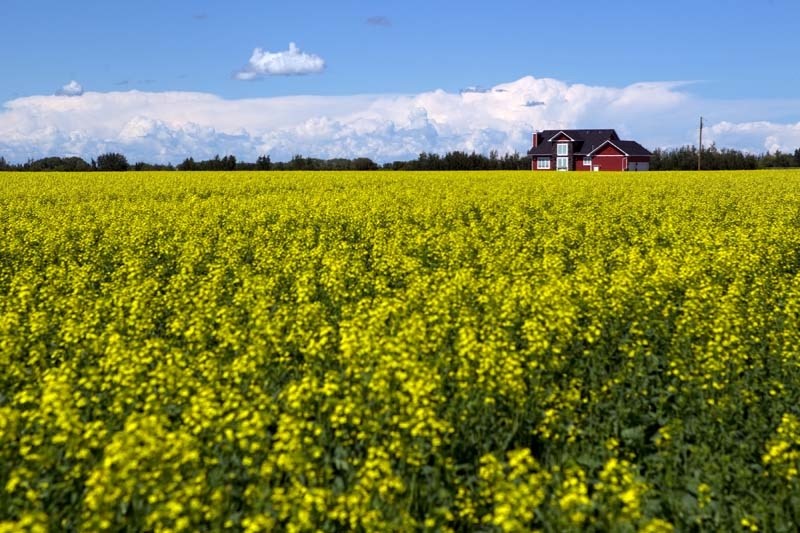It has been an up-and-down year for canola crops in the province, according to an agronomist with the Canola Council of Canada.
“Unfortunately, it's variable in that, as many really good and potentially pretty awesome canola crops, there’s some that are going to be a little bit disappointing just the way the growing season we’re dealt,” said agronomy specialist Jason Casselman.
On Aug. 25, the province released the Alberta Crop Report, current from Aug. 22.
The report said precipitation in the North West, North East, and eastern Peace regions of Alberta have helped crop development in those regions.
“However, the continued lack of precipitation in the South and Central regions is reported to have negatively impacted crops, as harvest progress is ahead of normal in these regions, while yield estimates remain below the long-term averages,” the report said.
Casselman, who is from the Peace region, said anything south and southeast of the Peace River caught some early moisture, but north and northwest missed out on those showers, which will likely affect the yield.
Alberta-wide, Casselman said some areas did not get “timely enough rains to meet expectations.”
Data from the regional crop condition report showed when it comes to canola, 42.3 per cent of the crops are rated in good-to-excellent condition, slightly below the rating for all crops in the province at 42.7 per cent. The five-year average for all crops rated good-to-excellent was 57.1 per cent.
Canola crop conditions in the North East region of the province rated good-to-excellent were rated the highest at 59.7 per cent, the Peace region was 54.3 per cent, the North West region was 34.2 per cent, the Central region was 33.4 per cent and the South region had the lowest number of canola crops rated in good-to-excellent condition at 16.4 per cent.
“Canola is pretty resilient," Casselman said. "Fortunately, our season does continue on. I know there are some growers that are harvesting canola or swathing canola and deciding enough is enough … and then there's others that don't see a frost in the future and they're going to let the canola crop continue to grow and finish off as best we can.”
Canola also had issues early on in the season.
“We saw some weird things, like with a lot of insect issues,” said Casselman, including cutworms after seeding, and alfalfa looper moths.
“We were gearing up for another big year on flea beetles. Fortunately, the flea beetles weren't as big of a concern. But some of the other insects in the canola crop we did (have concerns),’ he said.
In the southern part of the province, Casselman said there have been problems with grasshoppers.
Casselman said whether it’s pest or insects, growers need to keep an eye on what is happening on fields to identify and manage the top yield robbers.
“Switching to in-season disease pressure, I think some of the sclerotinia, because the crops had it flowered for such a long time," he said. "We had canola flowering for almost five weeks in some areas. Some of the sclerotinia pressure that was in the fields even where growers may apply the fungicide, there's still some sclerotinia showing up and (that’s) another pretty high potential yield driver that's affecting the canola crops.”
Again, Casselman is recommending farmers scout and do disease assessments, so they have a better understanding of what is going on in their fields.
In the dryer areas on the province, Casselman suggests growers look at the residual fertility in fields.
“If (growers) feel that the amount of fertilizer they applied for this growing season might not be totally used up, to get to get a really good gauge or estimate on doing some soil sampling and testing to see what's what is left in in the field going for next year,” he said.
This year also had a number of areas that saw a lot of smoke cover. There is not yet any data, but Casselman thinks the smoke may have acted to help buffer some of the solar radiation and heat stress.
Looking back over the years, Casselman said even after the drought in 2021, the crop potential was a little bit better in 2022 at this time of year.
“Unfortunately, we came into this growing season without many reserves for subsoil moisture. When we don't get in-season rain, a crop has to rely on what's in the soil, but we didn't have a whole bunch of that leftover. Last year there was maybe a little bit more subsoil moisture going in, even as dry as it was during the growing season in 2021,” he said.
However, some areas did catch up in moisture later on.
Overall, Casselman said, growers should do their best to manage their crops this year and to not give up.
“I think some of the later moisture that we had is encouraging to help finish off some of these fields — for sure, there's some that are that are too far gone,” he said.
Casselman said continuing to look forward is critical.
“I think this year it's just kind of following the basics of doing everything that you can as best as you can, and then doing that evaluation," he said. "Preparing for next year — soil testing, doing a really good inventory of what's available in the in the field for nutrients for next year's crop, and then building a plan to grow a really good crop next year.”
The full crop report can be found at https://open.alberta.ca/dataset/92dc0d33-edc7-47ec-be8d-a334ea145ded/resource/bb39ec02-8c4a-4025-a2df-3605c426078b/download/agi-itrb-alberta-crop-report-2023-08-22.pdf



